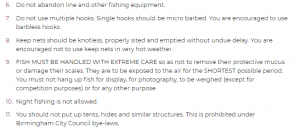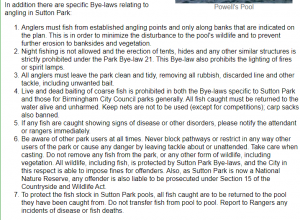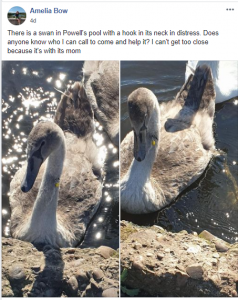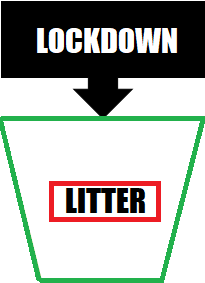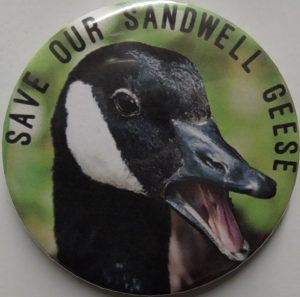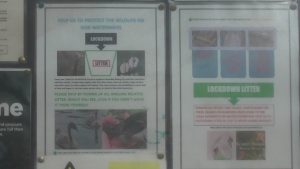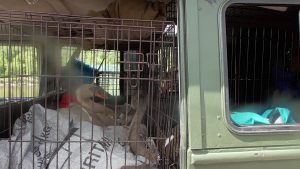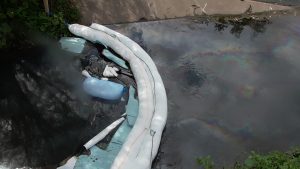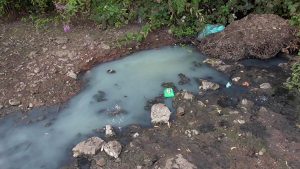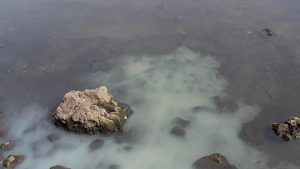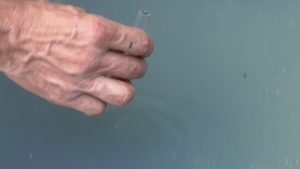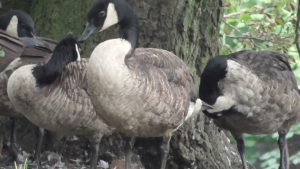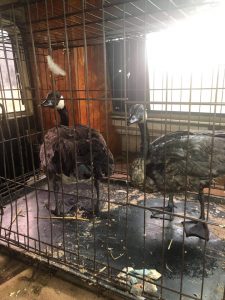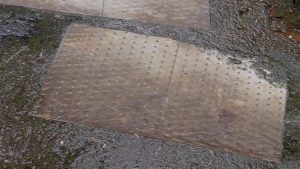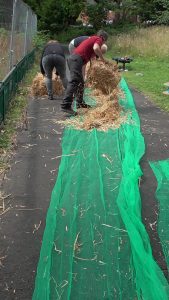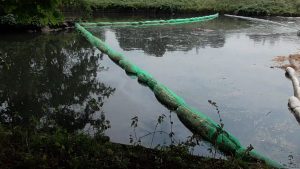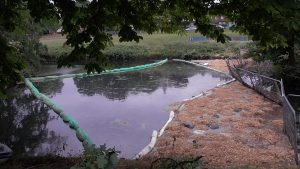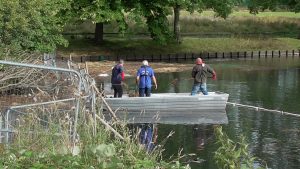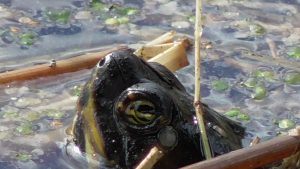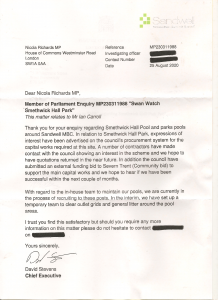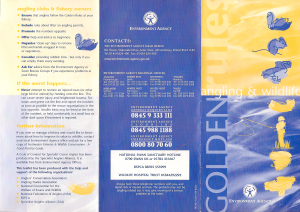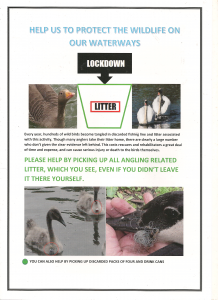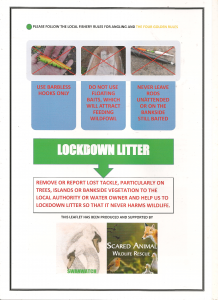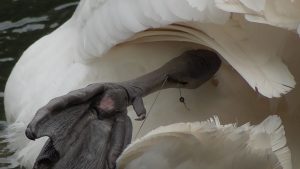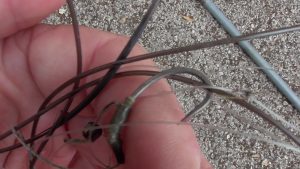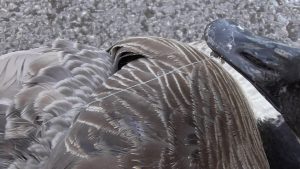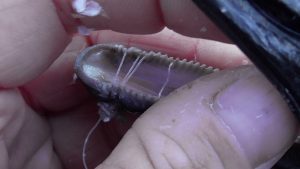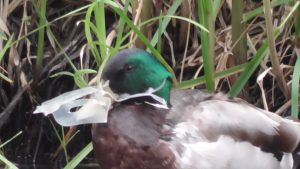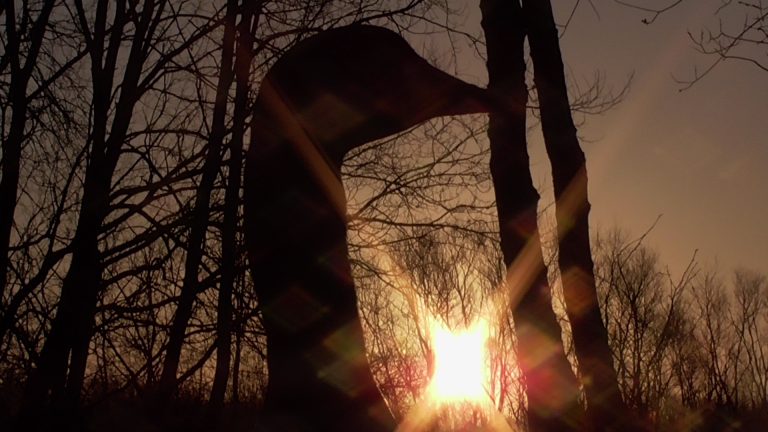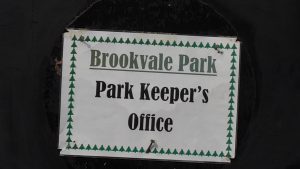
Though I have frequently had run ins with Sandwell MBC regards birds in parks, Birmingham City Council- the largest of local authorities has a very dubious track record on wildfowl and their welfare in its own. I have previously outlined how two ridiculous specimens wanted to cull geese in one Birmingham park with inflated claims. I have also set out how BCC park officers assisted the wildlife murderers at FERA with killing ruddy ducks at Witton Lakes.
I don’t like Birmingham City council and its parks department. Not only as a result of the issues highlighted here, but as a consequence of several years ago, when I along with others was targeted by them for actually daring to care. I noted that several birds on two of their lakes were becoming lead poisoned and needed help. Some park officers connected with ringing birds, and one odious “lord of the rings” individual who lives in Tamworth, thought they knew better, and attempted to smear myself that the birds were not ill and that I had “cleared a whole lake of swans”. This individual even went to other sites and asked one ranger at Chasewater; “has that little bastard been here again?” whilst repeating the lie obviously given him by those officers at Birmingham City Council.
The background to lead poisoning in swans, symptoms and occurence can be read in the PDF below written by a former MAFF veterinary pathologist, who attended National swan convention conferences, as I did, around this very same time. The Birmingham Parks were well known as “a lead poisoning blackspot” with frequent records of admissions to wildlife rescue centres- the vain staff in this department may not like that , but it is a fact based on the results of scientific tests.
leadpoisoningA&VHUNT
Even further and more bizarrely at the same time, certain same individuals within BCC libelled me in suggesting that I had been releasing birds from out of the area at Sutton Park, (without any proof), on the basis that a few were turning up with colour leg rings from outside of the area. Notwithstanding the fact that I don’t drive, and live many miles away from this site, these plankton appear to have failed to recognise that birds have wings, and also that the RSPCA release birds from their Stapeley Grange wildlife centre in Cheshire, which covers a vast area, to a site around 7-8 miles away from Sutton Park as the crow flies.
Every single bird taken off these lakes were confirmed to have elevated blood lead levels and required treatment, by independent academic testing at Keele university in a scheme paid for by The Environment Agency, with many not making it. BCC were sent these results by Wychbold Swan Rescue, but the stuck up jobsworth pomposity of these desk jockey’s was well remembered, especially when they even cosied up to the police in a desperate attempt to discredit me, but were forced to make an apology- as shown below- though this wasn’t made to myself personally.

Apology not accepted
Though the number of lead poisoned birds has declined at the pool since this time, there have from time to time been some noted to be showing the same symptoms which have required rescue- especially when the water levels have fallen sharply- and thus given greater access to shallow sediments in the lake. This will become a regular observation in this post.
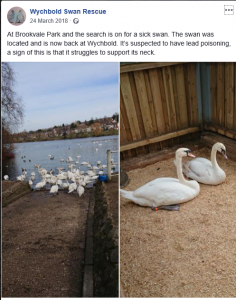
The numerous issues concerning SMBC’S disastrous managed pools in Smethwick/”botulism” and related Severn Trent water sewage pollution are noted. I have looked at botulism, its causes and effects in this post.
But issues of a similar nature have occurred and are reoccurring again in Birmingham, with the approach taken by this local authority mirroring the complacency and apathy that they showed with the lead poisoning situation at the very same site. Further more , it appears that certain actions which have been taken at this park, and at the knowledge of BCC have directly led to the occurrence of illness at the site, but the admission of this and failure to remove carcasses at the lake by BCC have not been.
I put them in the public domain in this post, because the illness and deaths of wildfowl at this badly managed lake are inextricably linked to the fluctuating water levels and increased access to contaminated sediment for bottom feeding birds, disturbed by water pumping operations in combination with festering dead birds and tree debris which act as an energy source for botulism.
In chronological order here is what appears to have happened at Brookvale Park in Erdington. Though illness with lead poisoning has been shown repeatedly at this lake, through lead shot discarded by anglers, the botulism situation had never occurred at this lake in the 22 years that I have been visiting there almost every week. That was until around July/August 2018- a very hot period of weather.
It is clear that some public facebook postings from this date showed that West Midlands fire service had attended the site and had “oxygenated the water”. It is not clear if BCC or any of their employees had formerly requested them to do so, yet this posting appears to suggest that one had.

31st July 2018
There was no valid reason for “oxygenating” the water, no fish were in distress at this time, and nor did the lake require it. In fact this action would have disturbed the silt at a time when the bacteria in the lake would have been at peak. It should also be noted that this lake goes up and down at violently fluctuating periods, and there has been no apparent reason cited for this. More on this and an investigation as to why below.
A further FB post reveals that WMFS were again at the lake on 27th October 2018– “doing exercises”.

I made a freedom of information request to BCC about the levels after complaining about this fact, and here is what they claimed in response.
(i)Please disclose if any Birmingham City Council staff have remit to or have been given permission to lower water levels in Brookvale Park, either on an ad hoc basis or within the last year. Which officer of the council grants such permission?”
No change in water levels has been undertaken by any officer. Any decision to change the water level at Brookvale would be determined collaboratively by drainage officers and the District Park Manager.
(ii)Please disclose if any individual, club or organisation have remit to or have been given permission to lower water levels in Brookvale Park, either on an ad hoc basis or within the last year.”
Birmingham City Council has never given permission for the water levels in Brookvale Park to be lowered.
(iii) To the City council’s knowledge, has any external authority have remit to lower the water levels at Brookvale park and may have done so within the last year?”
The environment agency might have reason to change water levels to facilitate inspection of downstream structures, but we are not aware of any such action within the last year.
(iv) Please disclose internal emails between Council officers within Parks/Highways/drainage and any other organisations in connection with the recently reported bird deaths at this site, and also the lowered water levels at the lake. I include in this any discussions to raise the water levels at the lake to prevent further deaths.
Please find these in the attached document.
The only emails supplied consisted of an email dated 13th December 2018 between someone from the APHA and the BCC animal welfare officer – this was after the first reported bird deaths were made public.
And the other dated December 14th from the BCC animal health enforcement officer , which requests that all of the dead birds be removed from the lake on a daily basis- (obviously up until now they were not from this admission), and that “paddy”- the park keeper was getting complaints from members of the public and the RSPCA.
It is even more surprising that the dog wardens would apparently be instructed to incinerate and therefore destroy any evidence for investigation as to cause of death without pursuing this avenue via the APHA.

The FOI request clearly appears to state that BCC and their staff did not lower the water levels at the lake, and were not responsible for this- yet they do own this lake, which is used for boating and sailing.
There may well have been an unreported or untraced sewage related issue at the same time, as with the situation at Smethwick, but the disturbance of the silt by WMFC would have been certain by these actions- directly resulting in botulism conditions being exacerbated.
The APHA guidance about being careful with suspected botulism and circulating potentially contaminated silt is noted.

It is noted, as will be evidenced, that the APHA sent this guidance to both the animal welfare officer at BCC, and also management at Sutton park- IN AUGUST 2018 FOLLOWING THE FIRST NOTED WILDFOWL DEATHS.
I made an FOI request to WMFC about why they were on the lake, and what they were doing, after also being sent pictures by a member of the public.
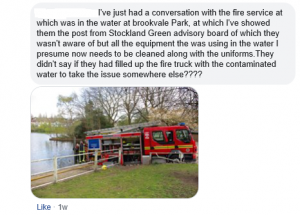
A relevant question as to whether the fire brigade knew what they were doing, and where the water was going.
(II)May I ask if any of these activities were at the request of Birmingham
City Council or any of their staff, on either a formal or informal basis?
(iii) Please provide any communications including emails and attachments
relating to such requests.
None the above have been on request of Birmingham City Council. However our crews do inform the park ranger of are visit.
(Compare this with the picture above and commentary!).
(iv)Can you state if any water has either been removed from or added to this lake by any of your staff and appliances over this period?
This information is exempt under section 1 of the Freedom of Information Act 2000 as we do not hold this information. We have not recorded if we removed or added water from this lake.
v) Are you aware of the perceived instances of suspected “avian botulism” at this site during this time following a number of deaths of birds, and what subsequent risk assessments have you carried out in respect of using this site, or the water/sediments contained within for your staff and appliances? Please provide any written information that you hold in relation to this.
This information is exempt under section 1 of the Freedom of Information Act 2000 as we do not hold this information. No records are kept in relation to “avian botulism” at this site and subsequent risk assessments.
I further queried some aspects of this response, as I considered it fairly poor.
On how many occasions have your staff pumped water from or to this lake during these operations?
WMFS has been 3 times to this site in the last 12 months, we have performed open water pumping training exercises.”
Could you please specify the dates and duration of activities if recorded.
Supply me with information held as to the nature of the “water pumping training exercises” , i.e any written information given to your staff in such a scenario.
On how many occasions have your staff pumped water from or to this lake
during these operations?
On the dates mentioned below the water is taken from the lake, into our pumps and sprayed back into the lake through hose.
Could you please specify the dates and duration of activities if recorded.
31st May AM
14th April AM
28th March PM
31st July 2018 AM
Precise times and duration are not record therefore this information I exempt under section 1 of the Freedom of Information Act 2000 as we do not hold this information.
NB they failed to give me accurate attendance of their activities at this site- on 27th October 2018 and 13th April 2019- just for two ! One must therefore wonder just on how many actual occasions these reckless actions were taking place with repeat disturbance of the silted water?
Supply me with information held as to the nature of the “water pumping training exercises” , i.e any written information given to your staff in such a scenario.
Please find link below to water pumping training exercises.
Fire Service Manual_Volume 1 – Fire Service Technology Equipment and Media – Hydraulics_ Pumps and Water Supplies
from chapter 6 onwards.
The information from Chapter six appears to demonstrate the effects would be from such open water pumping activities. It is not clear if they used “The Holland Fire system” of pumping water, but given it is in their training manual, it cannot be discounted.
The “open water training” – as reported by one of their own staff- note the date of this, as it will become important as to the consequential result, but does not appear to match up with the claimed date of April 14th (as above) when it was stated they were there.
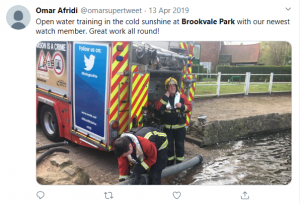
On 12th April– before their supposed arrival and 15 days after their previous claimed visit of March 28th, I observed a clearly sick swan on the lake and recorded the symptoms for evidential purposes in this video . I also rang the RSPCA to collect the swan which was clearly in serious distress.
https://www.facebook.com/950337051658707/videos/2284519378236285/
A further spell of death was noted on the lake after the visit on 13th/14th April- see further pictures below taken on 18/4/2019.
These events clearly followed WMFS activity of pumping and disturbing silt within the lake, and cannot be dismissed as coincidence. But the actions of this council or lack of them in leaving dead birds in the water had been occurring for many months up to this period.
It is quite clear from social media postings by members of the public , that bird deaths had been occurring throughout the autumn of 2018, (in conjunction with the WMFS activities at the site, but had only been publicly reported and acknowledged – quite inexplicably when the local neighbourhood police had warned people about not letting their dogs near the water because of a number of dead birds- particularly swans. They stated that this was “on behalf of the park keeper”, yet no reason is given as to why the management of this park /environmental health had failed to communicate the message through their own BCC communications channel employees? The Birmingham Mail picked up this story dated 16th December 2018.
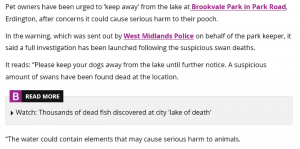
The article claims that investigations had been launched into the deaths, but it appears that they already had some inkling given the comment about “elements that may cause harm to animals”- whatever that is supposed to mean. It is difficult to see how any investigation was taking place when someone from within BCC was requesting that the birds be incinerated- as per the obtained email from the FOI above dated two days before this article was written. No evidence of cause of death would be obtained, if none of the birds were even being sent for post mortem to the APHA. I would put it that far too much time had passed, with little to no response from BCC as to the unfolding situation at this park.
Again, the APHA guidance about leaving dead birds in the water and not removing them is clear.

I made formal complaints to BCC about the dead birds , and the fact that they were not being removed promptly, and the lake and its management, to which I received a very inadequate response. I also sent the manager of parks in BCC, Joe Haden, the APHA guidance on botulism outbreaks- link, as evidenced in the email below from April 7th 2019. Of course, as will be revealed further on, they had already been sent this by the APHA themselves.
avian botulism
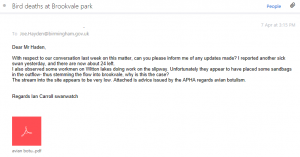
At the same time that myself and the RSPCA were noting and rescuing ill birds at the pool, as well as noting the council’s inadequacy to promptly remove them, another Birmingham Mail article appeared quoting a local resident who had also been tirelessly trying to get answers as to why so many birds were dying on the lake, and noted that the situation had been ongoing since the year before.
The headline to this was
“Dead swans and rotting carcasses wash up at Brookvale Park in Erdington”
There are some quite extraordinary statements made by BCC employees, which need to be highlighted here, both for their callous disregard for the welfare of the birds in an assumed avian botulism situation, the lack of following the APHA guidance, and also statements which are just false concerning botulism in birds.

- The statement about the prolonged dry spell simply is not true. As evidenced by the picture from 31st July 2018, the level of the pool was not affected by any lack of rain or evaporation, but falls in water levels were as a result of water being let out of the pool by some means- drops of 9-10 inches were noted to be taking place within a single day- see indisputable evidence further on in this post.
- The council try to pass this off as a natural occurrence, yet omit their role in failing to remove dead birds promptly from the water, removing dead tree debris from the lake, and actively allowing the fire service to use the lake- all factors in increasing the risk of avian botulism, as defined by the APHA guidance.

- Incredibly the council identify the low water levels in conjunction with the deaths and the birds ability to now reach the silt, yet appear clueless as to why this has occurred.
- “Once birds contract the disease, there is no cure available”.
This statement needs to be scrutinised and fact checked for accuracy. You can play around with semantics about “cure” , but the council here appear to be implying that there is no treatment available and the birds cannot be saved and will all die after contracting illness. This is simply not supported by factual evidence.
The APHA guidance, supplied to BCC states the following,
“Treatment regimes, including careful oral administration of warm water to flush toxin from the gastro-intestinal tract in early cases, and nursing can be effective.”
The council refer to outbreaks across the country of AB, and it is clear from some outbreaks at different locations, that intervention by catching ill birds in a timely manner ,administering treatment, and removing them from the source of risk has resulted in them being saved and therefore “cured”.


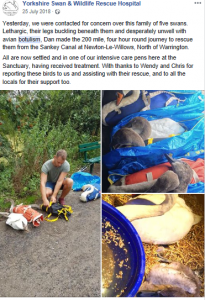

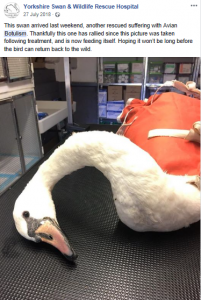
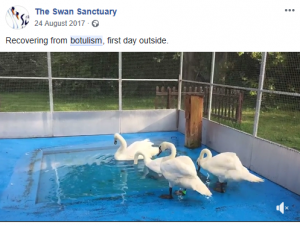


NB. At least one of these birds was from Brookvale- collected by the RSPCA.
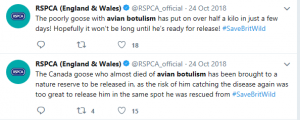
Bird recovered with care from the RSPCA, but was not released into the same contaminated and untreated environment it had come from.
I also give the following case study of three recovered treated Canada Geese that we rescued last year from polluted pools in Smethwick, and which were taken to Linjoy Wildlife sanctuary. The notes here were written by the experienced rehabilitator.
smethwick geese treated
These occurrences rubbish the claims made by BCC, and show that care and treatment can “cure” ill birds, but that it is the pools themselves which need to be treated and cured to prevent the risk to start with.
All of these organisations under the guidance of veterinary professionals chose to try to save lives rather than sitting on their flabby buttocks promoting that it was better to leave the birds to suffer in situ to die.
Furthermore, on this point , an extract of the go to manual for veterinary professionals, from chapter 38 “Nervous diseases of the manual of raptors, pigeons and waterfowl” This is a table concerning the treatment for botulism type C- the avian botulism suspected in this case.

“If antitoxin and fluids are used to flush toxin from gut and bloodstream, 75-90% of affected birds may recover” (Olsen , 1994).
Further statements in the BM article

- Clearly staff were not removing birds promptly, as was noted in the December BCC email when they were noting just this after complaints from members of the public! And the whole driver of the April BM story and the pictures show dead birds left in the water for several days. This was also my own personal observation which I know to be true.
- “It would be counter productive to remove any sick birds as this would create stress on those creatures with no prospect of recovery”
This statement has already been factually disproven, but becomes an outright mistruth here!
The care of this BCC spokesperson is none existent, who appears to be suggesting that the birds should just be left to die, by drowning and then removed at a later date. How an ill bird suffering from the prolonged effects of this illness and then slowly fading away to drown is NOT suffering stress is beyond me!
- The water level is referred to as being back to “normal levels”- whatever that means.
- The statement about brookvale being a great site is hopeful fantasy when they appear to be doing nothing to control the factors causing it.
A further email along very much the same lines as the person quoted from BCC in the article was publicly posted on facebook, and is written by John Porter. A local member was also copied in.

- He repeats the statement falsely of “no cure or treatment available”.
- “There is nothing meaningful to be done”. Perhaps this one line summary shows exactly what BCC management are all about. The apathy here is incredulous- clearly there are many things “meaningful” that could be done, its just that lazy people do not want to do them.
- He claims that “we are in the hands of nature”- again not the truth when manmade intervention of lowering the levels of the lake by 9-10 inches is causing the water to fall, and not hot weather.
All I can say to Porter and his ilk is that it’s a good job that some people think that there is something meaningful to be done and attempt to help wildlife at this neglected managed site.
On spending a great deal of time at this lake in March/April of last year, I had cause to ring the RSPCA on several occasions to report ill birds, as well as to BCC itself- (without much interest from them).
Following the media story and my complaints, as well as concerns expressed privately which I know about by the RSPCA, the council started to finally collect dead birds from the lake and island. A boat was brought onto the site by Birmingham rangers on 18/4/19- (note just 4/5 days after WMFC had reportedly been at the lake on pumping exercises- see evidence of this above), though for reasons unexplained, the park keeper based at Brookvale appears unable to use it.



18/4/19

18/4/19

18/4/19

18/4/19 Sutton park rangers…. “clearing a lake of (dead) birds” at Brookvale park.

18/4/19 Ill bird suffering from symptoms of botulism , but more interested in picking up the dead. “Great work all round”
Bizarrely on this visit, when they could be bothered to bring a boat onto the site from the Mecca at Sutton Park , despite me telling them about the ill one pictured which was starting to drown, they sailed on past on the hunt for more dead birds, presumably in case the press turned up again with a long lens.
I also started to investigate the water source out of this park and where it went, scaling fences and following the brook course towards Spaghetti Junction at the M6.
I was sent the following pictures of the slipway by a member of the public, after the RSPCA had attended the site to pick up more dead birds and look for ill ones. He took pictures on this day, and the subsequent day after that. At this point the City council started to use their dog warden to allegedly look out for ill or dead birds. Again I would ask the question, was this not the park keepers job for this site?

The RSPCA retrieve 2 dead swans from the BCC lake on 10/5/19
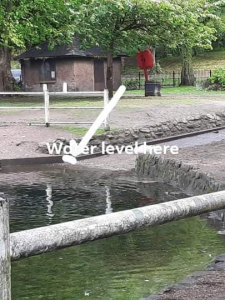
Taken 10/05/19
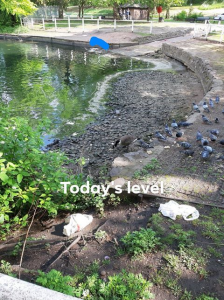
Taken 11/5/19 – a clear massive drop in water level in matter of hours.

And back again to 10/5/19 hours earlier when the RSPCA had been in the water with their boat.
I then went to verify this for myself on 12/5/19 and took the following pictures which confirmed that the levels in the lake HAD dropped by 9-10 inches in just that time.

Taken 12/5/19 which shows just how much water had disappeared from the slipway in the two days.

opposite angle showing now exposed brick and silt. The water level just 2 days earlier had been at the base of the wall.

Measuring the clear scum line where the water had been revealed the drop from where the base of the wall begins.

Green scum line indicates the drop in level in two days

The outlet from the pool, again water level drop line clear.

Opposite end of culvert out of brookvale showing rubbish debris collected – but appears to have been rodded.

The brook continues in the direction of spaghetti junction but was very low suggesting water had been let out.

Near spaghetti junction gate 2 where another culvert flows towards the River Tame- was this also cleared resulting in a dramatic water level drop?

At the other end of the lake where the water flows in from Witton Lakes, clear tree debris and brickwork was also apparent and exposed silt.

The question that I would ask from this clear draconian drop (which has been noted on many occassions), is why no staff at BCC, principally the park warden considers this something not to be reported and investigated in light of the clear damage it is doing to the fauna at this site?
Despite communicating this information to BCC officers, they paid no attention whatsoever to the drops in water level, and this line appears to be continuing even in the face of the clear evidence I have provided. Instead I was lectured about “climate change” and weather conditions being repsonsible- well that is bullshit!
APHA bird death reports
I managed to obtain some APHA post mortem reports from Birmingham City Council on request. It appears that they had sent some birds for post mortem in August 2018. It is noted that these were in a very poor condition according to the APHA, suggesting that they had been in the water for some time.
Joe Haden in an email dated 18/4/19 stated the following.
“Initially over concerns over Avian Influenza (AI), a number of dead birds were removed and sent to the laboratories to test for AI as a matter of course, consistent with Defra’s current guidelines on dealing with the threat of AI. Discussions were then had with a Veterinary Investigation Officer based at APHA’s Shrewsbury Veterinary Investigation Centre, who carried out the post mortems and took samples for testing. He then provided advice, confirmed there was no AI or West Nile virus (also a notifiable disease) detected and sent a link to the Defra guidance. The presumptive diagnosis of Avian Botulism was discussed and confirmed in an email received on 9 August 2018, together with the laboratory report, this was sent to the Senior Animal Welfare Officer and Sutton Park Hub.”
APHA reference 26-B0037-08-18 related to a black headed gull and a herring gull.

” unfortunately both these carcasses were not in fresh condition and the herring gull was particularly decomposed and not suitable for further testing. It has not been possible to reach a diagnosis in this case.”
A further submission APHA reference 26-B0062-08-18 consisted of two dead Canada geese and a swan. An interesting statement is made about the initial outbreak of the disease- (following remember the WMFC activities on the lake one week earlier).

” The report received on 7th August was of sick swans and Canada geese. Affected birds were weak and lethargic with flaccid wings, noticeable when in the water, and one swan could not stand and one goose was seen with ‘discharge’ at the corner of the eye. The RSPCA had euthanased some clinically affected birds. The park contains a large number of swans, geese, mallards and coots; approximately 20 birds have died so far.”
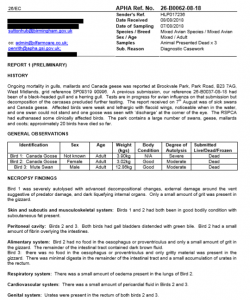
The finding of presumptive diagnosis of avian botulism was supplied by the APHA , and at this stage they even sent BCC a copy of the avian botulism PDF- supplied to “the senior animal welfare officer at BCC and The Sutton Park Hub.” SO WHY DID THEY COMPLETELY IGNORE THIS ADVICE GOING INTO DECEMBER- AND ALSO FAIL TO INFORM THE PUBLIC , ONLY VIA THE POLICE, UNTIL THIS TIME?!!!
The fact that many birds were also being put to sleep is also concerning in that they were never given any chance of recovery.
“In view of the clinical signs described and the post-mortem findings the presumptive diagnosis is avian botulism as discussed on the telephone.
I enclose a link to further information about botulism.
http://apha.defra.gov.uk/documents/surveillance/diseases/avian-botulism.pdf
A key initial feature of control of outbreaks is that all dead birds should be promptly removed as these are a potential source of toxin. The toxin may be frequently found in maggots feeding on dead birds and these represent an important was (sic) of toxin dispersal to feeding water birds. Further detail is given in the document in the link. “

With a lack of clarity over what was happening with these birds from either BCC or the RSPCA in 2019, or if botulism had been identified instead of just “suspected” , I submitted an FOI request to the APHA, citing The Birmingham Mail story concerning the dead swans.
“Could you please confirm if you have carried put any post mortems on wildfowl from Brookvale Park Birmingham , West Midlands- approximate nat grid reference SP091911 and supply me with the preliminary, supplementary and final reports concerning recent bird deaths .
https://www.birminghammail.co.uk/news/mi…
Can you CONFIRM that these birds died from avian botulism, and was this a “presumptive diagnosis” without carrying out a test for this summer related illness?
I believe these may have been submitted to the Shrewsbury laboratory since December. “
The APHA responded with several attachments which appear to confirm that BCC had done nothing since the first deaths to investigate by scientific means as to what the cause of deaths were in these birds other than “presumptive diagnosis”. The deaths remember had been occurring for many months before this time, and the APHA had already sent them literature on methpds of prevention. For some reason however, the APHA failed to provide the recent 2018 Brookvale post mortems, which is very remiss given that it is within the scope of the request.
APHA Ref. No. 26-B0002-01-19
Relates to the submission of birds collected by the RSPCA from the lake, 3 swans, 1 Canada goose and 1 coot. All were reported to be in good bodily condition, and two of the swans had just been put down at the pool.

The RSPCA had clearly given the APHA a degree of background information into the issues at the site- “Approximately 20 to 30 birds were reported to have died over two weeks including three coots, one tufted duck, two Canada geese, one domestic type goose and the remainder Mute swans. Birds have been found dead or been found weak with droopy wings leading to inability to fly and walk. Some have been taken to RSPCA Wildlife Hospital and Vale Wildlife Hospital for treatment and some have died or been euthanased at the lake. Botulism was suspected from the clinical signs.”
Furthermore and to confirm my own observations as described in this post
” The water level on the lake has been decreasing and the reason for this is being investigated.”
It is stated that one of the swans had a lead level of >600, (with metallic fragments seen on x ray), which probably refers to micro grams, and is a very high level- which again supports the statements I have made about historic lead poisoning with swans at this site in conjunction with decreased water levels.
The other comments also support everything I have stated in this post, and it is clear that the RSPCA had shared my concerns with the APHA.
“I understand that there are concerns about the low water level in Brookvale Park and also there may still be carcase remains around the edge of the lake particularly on the island which would be a good source of toxin. I enclose a link to information about avian botulism, one of the key principles in the early stages is to remove all carcase material and rotting organic material and improve the water quality. I would be interested to receive further information about how this is progressing and discuss clinical findings in the live birds at the RSPCA Hospital.
http://apha.defra.gov.uk/documents/surveillance/diseases/avian-botulism.pdf
BVSc MSc MRCVS Veterinary Investigation Officer
04/01/2019″
N.B This is exactly the same PDF I had sent to Joe Haden in February, but which Birmingham City council officers had already been sent by the APHA in August 2018 already.
Subsequent tests showed no presence of avian influenza in the five birds.
They also tested for duck viral enteritis, a highly contagious disease in wildfowl, which again proved negative.
The suspected lead poisoned bird was tested for lead- finding a very high lead level which confirmed that this was the cause of death in this case.

“COMMENT
The kidney lead level is equivalent to 59.89µmol/kg wet matter, 50.8µmol/kg dry matter. This together with the impaction of the oesophagus and suspected high blood level is consistent with lead poisoning.
The birds examined were in relatively good body condition with good reserves of body fat apart from Bird 5 which had findings consistent with lead poisoning. The clinical history and lack of obvious gross lesions in the others is suggestive of avian botulism. We have not found evidence of Avian Influenza or Duck Viral Enteritis.”
A test for botulism was carried out on just one bird – a swan which proved negative, but presumptive cause of death was attributed to botulism- but the contributing factors are quite obvious to this, as expressed by the report. Perhaps
“there was something meaningful to be done”.
Whilst fannying about with my complaint, BCC waited until they had another post mortem result which finally confirmed a single bird had tested positive for botulism, as though this was some form of case closed for them, to do nothing at all about remedial matters caused by their incompetence and pathetic management of silt over many years, as well as major tree debris in the lake that had been there throughout the same timeframe.
This APHA reference 26 B0243 04 19-08 (1) related to another swan which appears to have been sent in April of 2019- again following the WMFC activities at the lake. Once again, the investigating officer at The APHA provides the BCC ignored link to avian botulism.
And then abruptly in July 2019 the deaths appeared to stop. I have asked BCC if WMFC had attended the site, or had been asked not to and got the following response from Joe Haden.
“We have no record of West Midlands Fire Service using the site for training and have not given permission or been contacted with any request to use the lake in this way.”
This of course doesn’t answer if they have.
In March 2020, out of the blue, a report from a member of the public at Brookvale came in via a rescue centre of a bird in distress at the site. From the symptoms of the swan it was obvious as to what had returned. But despite the poor prognosis, this bird made a full recovery WITH TREATMENT at the Linjoy Rescue centre in Derby.
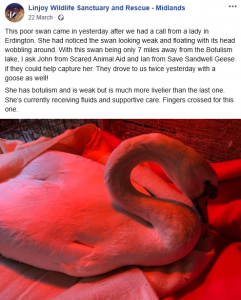
NB “The botulism lake”, refers to one of the Smethwick parks.
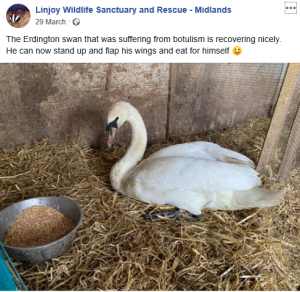
But it wasn’t the last, and noting once again dramatic sudden drops in water levels, we are currently again in a spiral of bird deaths at this lake- particularly it seems affecting swans, which are of course able to access the deeper sediments.

Once again I have measured a 9-10 inch water level drop over a matter of hours.
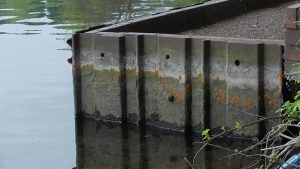
It is clearly visible where the water level had recently been, any blind man could see this.
Despite this , this is what I have received from Joe Haden on this matter.
“Local Parks officers and Main Drainage colleagues have both followed up with their respective EA contacts as you’ve requested below. Both lines of enquiry have confirmed that the EA have not carried out any works locally that would affect the water level at Brookvale or Witton. EA visit the lake weekly and are of the view the changes in water levels (up and down) are in keeping with that location.”
So the EA, according to BCC believe that a 9-10 inch drop (up and down) is acceptable, despite the abysmal environmental damage that it is causing- which I believe is down to these very same people removing blockages down the line.
Despite claiming that they would be erecting signage at the lake telling people about avian botulism and other matters around this time last year, but failing to have done so, the following signs have suddenly appeared following the resumption of the dire situation.
The focus of these signs, and the misinformation contained within them appears to be focussed on the public, and not on the failed managment and animal welfare concerns of Birmingham City Council. We have linkages to eutrophication and their favourite anti bread message.


And AB is also caused by leaving branches in the water for months and not removing them, allowing the fire service onto the lake to recklessly disturb the water, and also leaving piles of dead birds to rot in this soup whilst allowing water levels to violently fluctuate- but BCC choose to not tell the public about any of this. I wonder if it’s because that would involve them doing something “meaningful” ?



